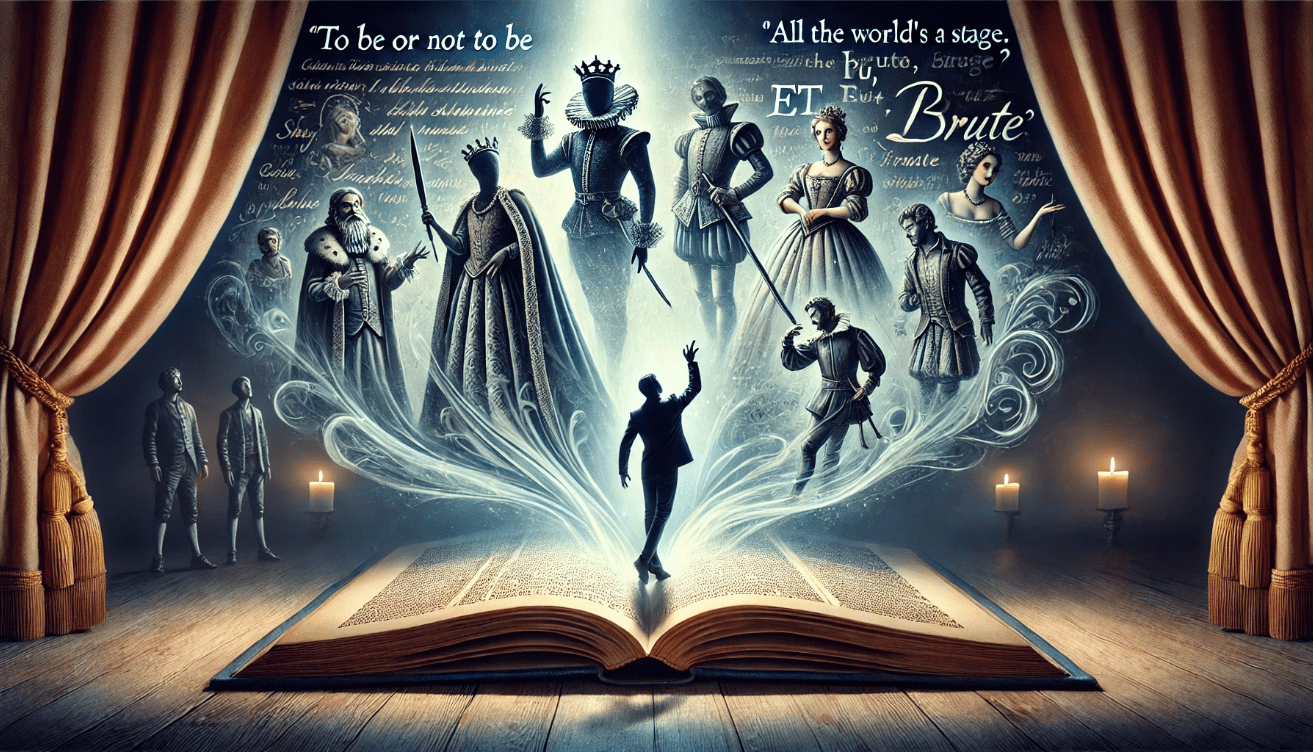
How Soliloquies in Shakespearean Theatre Reveal Character and Drive Plot: Unlocking Their Dramatic Power
🎭 Ever wondered how Shakespeare’s characters seem to speak directly to your soul—revealing their deepest fears, desires, and intentions? It’s not magic, but rather the strategic use of soliloquies, one of the Bard’s most powerful storytelling tools. The role of soliloquies in Shakespearean theatre goes far beyond poetic flair—they serve as windows into a character’s mind and engines that quietly propel the plot forward.
Yet, many readers and even performers overlook just how essential these moments of introspection truly are. Why do they matter so much? And how can understanding them unlock a richer appreciation of Shakespeare’s work? Let’s dive in.
Table of Contents
Toggle1: What Are Soliloquies and Why Are They Important?
A soliloquy is a moment in a play when a character speaks their thoughts out loud—usually alone on stage—revealing what they’re really thinking or feeling. Unlike dialogue with other characters, soliloquies are private. It’s as if the character is speaking directly to the audience or to themselves. 🎭

In Shakespearean theatre, soliloquies serve a powerful purpose: they give the audience insider access to a character’s mind. You’re not just watching the story—you’re being pulled into the emotional core of it.
1. They Reveal True Character
On the surface, a character might appear brave, loyal, or even innocent. But their soliloquies often tell a different story. For example, in Macbeth, the famous “Is this a dagger which I see before me” speech shows us Macbeth’s inner turmoil long before he commits murder. Without that soliloquy, we might misunderstand his motivations entirely.
2. They Drive the Plot Forward
Soliloquies don’t just sit there for dramatic effect—they often signal a turning point. When Hamlet says, “To be or not to be,” he’s wrestling with life and death. This moment prepares us for the choices he’ll make later. The audience gains clarity before the action unfolds.
Real-World Relevance
Understanding the role of soliloquies in Shakespearean theatre helps students, actors, and fans of drama connect more deeply with the material. Whether you’re analyzing a play, performing on stage, or just reading for fun, paying attention to soliloquies can change how you interpret everything.
2: How Soliloquies Reveal Character
Soliloquies are like open diaries—unguarded, honest, and deeply revealing. In Shakespearean theatre, they let the audience step inside a character’s mind, offering insights that no other form of dialogue can provide. 🎭

1. They Show Internal Conflict
Characters in Shakespeare often face difficult decisions. Through soliloquies, we witness their emotional struggle in real time. Take Hamlet’s iconic “To be or not to be” speech. He’s not just musing on life and death—he’s caught in a battle with himself over action vs. inaction.
2. They Expose Desires and Fears
Soliloquies strip away masks. Whether it’s Macbeth’s ambition, Lady Macbeth’s guilt, or Iago’s jealousy, we get to see what drives each character at their core..
3. They Highlight Transformation
Shakespeare often uses soliloquies to show how characters evolve. As the play progresses, their tone, language, and priorities shift. Early soliloquies might show hesitation; later ones reveal confidence—or deeper despair.
4. They Build Emotional Connection
When a character speaks alone on stage, it creates intimacy. The audience becomes their confidant. This emotional closeness makes us care more deeply—whether we agree with them or not.
🧠 Action Step: If you’re performing or studying a soliloquy, think of it as a private conversation with the audience. That personal touch brings the character to life.
3: How Soliloquies Drive the Plot
Soliloquies don’t just reveal character—they move the story forward in powerful, often subtle ways. In Shakespearean theatre, they act like invisible hands, pushing the plot into motion while giving the audience a front-row seat to each twist and turn. 🎬

1. They Signal Key Decisions
Soliloquies often appear right before a major choice or turning point. These inner monologues let us watch the character wrestle with options—and ultimately make a decision that changes everything.
👉 Example: In Macbeth, the soliloquy “If it were done when ’tis done…” shows Macbeth weighing the pros and cons of killing King Duncan. By the end, he’s leaning toward murder—setting the plot in motion.
2. They Build Suspense and Foreshadowing
Because soliloquies share a character’s secret thoughts, they often hint at what’s coming next. This creates dramatic irony—where the audience knows more than other characters—and ramps up the tension.
3. They Shift Audience Perspective
Sometimes, soliloquies change how we view a character or situation—nudging us to see the story differently. This shift in understanding adds emotional depth and complexity to the plot.
4. They Create Pacing and Rhythm
Shakespeare carefully places soliloquies to slow things down before a major event—or to give the audience time to process what just happened. They act like narrative pauses, offering reflection before the next act.
4: Decoding Shakespeare’s Language in Soliloquies
One of the biggest challenges readers face with Shakespeare? The language. ✍️ His soliloquies are rich, poetic, and often filled with unfamiliar words or phrases. But here’s the good news: once you learn how to decode his style, the meaning becomes much clearer—and incredibly powerful.
1. Look for Key Emotions First
Before you dive into word meanings, ask yourself:
What emotion is this character feeling?
Fear, guilt, love, anger, confusion—Shakespeare’s soliloquies are fueled by strong emotions. Identifying the dominant feeling helps you interpret the rest of the speech with better context.
2. Break It Down Line by Line
Don’t try to absorb the whole soliloquy at once. Instead, read it slowly, line by line. Translate each part into your own words.
👉 Tip: Read aloud! Hearing the rhythm and sound of the words often helps with comprehension.
3. Watch for Imagery and Metaphors
Shakespeare loved vivid imagery. In soliloquies, characters often use metaphors to express feelings they can’t say directly.
🎭 Example: When Macbeth says, “Life’s but a walking shadow,” he doesn’t just mean life is short. He’s saying life feels meaningless—like an actor playing a part and fading away. That’s a big insight into his despair.
5: Why Soliloquies Still Matter Today
You might wonder: Why should we care about soliloquies in a 400-year-old play? 🤔
The truth is, soliloquies remain incredibly relevant—not just in theatre, but in how we understand people, storytelling, and even ourselves.
1. They Teach Us About Human Nature
Soliloquies reveal the unfiltered thoughts of a character—something we rarely get in real life. They show internal conflict, moral dilemmas, fear, ambition, love, and doubt. These are universal experiences that still resonate today.
2. They Shape Modern Storytelling
You see soliloquy-style storytelling all the time in film, TV, and literature—think of voiceovers in movies, journal entries in novels, or direct-to-camera moments in shows like Fleabag or House of Cards.

🎬 These modern tools borrow directly from Shakespeare’s technique: letting characters break the fourth wall to share their inner world.
3. They’re Powerful Tools for Actors and Writers
For actors, soliloquies are the ultimate test of skill—no distractions, just you and the audience. They demand emotional honesty and connection. For writers, they’re a masterclass in building tension, revealing character, and advancing plot through internal dialogue.
6: How to Analyze Soliloquies for Study or Enjoyment
Whether you’re a student, actor, or just a curious reader, analyzing Shakespeare’s soliloquies can unlock a deeper understanding of the play—and make the experience far more enjoyable. 😊
1. Start with the Context
📍Ask: What’s happening in the story before this soliloquy?
Understanding where the soliloquy falls in the plot helps you figure out why it’s being said. Is the character facing a big decision? Reacting to a betrayal? Planning their next move?
2. Identify the Emotion
🎭 What is the character feeling as they speak—fear, anger, hope, guilt?
Pinpointing the emotion helps you read the soliloquy with the right tone and understand what’s driving the character beneath the surface.
3. Break It Down by Thought Units
Don’t treat the soliloquy as one long speech. Instead, divide it into smaller thought units or shifts in emotion.
🧠 For each part, ask:
- What is the character saying here?
- How does their thinking change from one part to the next?
Soliloquies are more than just beautiful speeches—they’re the emotional core of Shakespearean theatre. They give voice to private thoughts, expose inner struggles, and quietly shift the course of the plot. By understanding the role of soliloquies in Shakespearean theatre, we unlock a deeper connection to the characters, the story, and even ourselves. 🎭
Whether you’re a student trying to grasp meaning, a performer bringing lines to life, or simply a fan of great storytelling, soliloquies offer timeless insight into human nature. With the right tools—context, analysis, and curiosity—you can break down these powerful moments with confidence and appreciation.
Frequently Asked Questions (FAQs)
1. What is a soliloquy in Shakespearean theatre?
A soliloquy is a speech where a character speaks their thoughts out loud, usually alone on stage. It reveals their inner feelings, thoughts, and conflicts directly to the audience.
2. How do soliloquies reveal a character’s true personality?
Soliloquies give characters a private moment to express thoughts they hide from others. This helps the audience understand their real motivations, fears, desires, and emotional struggles.
3. Why are soliloquies important to the plot in Shakespeare’s plays?
Soliloquies often mark key turning points in the story. They show decision-making in real time, foreshadow future events, and help the audience track how the plot is evolving.
4. What are some famous examples of soliloquies in Shakespeare?
Famous soliloquies include “To be, or not to be” from Hamlet, “Is this a dagger which I see before me” from Macbeth, and “Tomorrow, and tomorrow, and tomorrow” also from Macbeth. These speeches explore deep emotional and philosophical themes.
5. How can I better understand the language in Shakespeare’s soliloquies?
Start by breaking the speech into smaller parts and translating them into modern English. Focus on the emotion behind the words, and use tools like glossaries or side-by-side translations if needed.
6. What’s the difference between a soliloquy and a monologue?
A soliloquy is a character speaking their thoughts aloud when alone, revealing their inner self. A monologue is a long speech directed at other characters or the audience and may not reveal personal thoughts.
7. How do actors use soliloquies in performance?
Actors treat soliloquies as intimate moments with the audience. They use tone, body language, and pacing to make the character’s internal conflict feel real and emotionally engaging.
8. Why are soliloquies still relevant today?
Soliloquies explore timeless human emotions—doubt, ambition, love, guilt—that still resonate today. Modern storytelling in TV and film often uses similar techniques, like voiceovers, to share characters’ inner thoughts.
